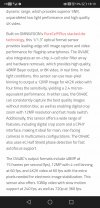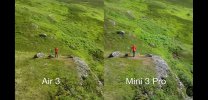The
Mini 3 Pro,
Air 3 and the new Osmo Action 4 all use the same Omnivision OV48C. Omnivision only makes one 1/1.3" 48MP sensor (
Product Archive ). The OV48C was released in January 2020 (
New OMNIVISION 48MP Image Sensor Provides Unparalleled High Dynamic Range and 4K Video Performance for Flagship Mobile Phones ), 2 years before the
Mini 3 Pro.
Here's the datasheet:
https://www.ovt.com/wp-content/uploads/2022/01/OV48C-PB-v1.1-WEB.pdf
In 2023, it's still a beast. Back Side Illuminated (BSI) for more efficient pixel cells; on chip dual conversion for improved dynamic range; pixel binning for better low light at 12MP/4k; and stacked die for improved pixel readout. It clearly outguns the
Air 2s in most uses, particularly 4k/60 where the
Air 2s crops from 5.3K, reducing the usable sensor size.
But better imaging in the
Air 3? Main camera to main camera the
Air 3 has an improved image processor so it can support 100FPS and better raw processing. I imagine operations like panorama processing are faster. Otherwise, they are identical as shown in this detailed comparison with a test charts:
The color science in video *is* different; the
Mini 3 Pro seems to have dialed up the saturation to appeal to the general public rather than video-graphers. That can be readily corrected. Of course, there's a second camera on the
Air 3 to have a narrower second FOV (tele zoom) and lots of other features.
Keep in mind, until about 2 weeks after the
Air 3 actually shipped, all reviews were made by people who got free equipment from DJI and signed an agreement to get the free drone. Take what you read about "improvements" that are not on the DJI datasheet nor documented in any public way by DJI with a grain of salt.
Expect the
Mini 4 Pro to have this same sensor; it is too soon to have the Mini product line outgun the Air product line. Expect the Air 3s to have m43 but only when DJI has taken all the money if can from people upgrading to the
Air 3 and the
Mavic 3.
To back to the OP's question: Am I concerned with the downgrade from 1" to 1/1.3"? No, the 1/1.3" is a significant step up in technology. But I made that decision when I bought the
Mini 3 Pro.













